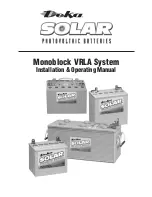
System Design ................................................1
Battery Operation
Temperature ....................................................1
Depth of Discharge (DoD) ..............................1
Charging ..........................................................1
Inverter/Charge Controller Settings..............1
Bulk............................................................2
Absorption..................................................2
Float ..........................................................2
Equalize ....................................................3
Maintenance ....................................................3
Battery Location
Space ..............................................................3
Floor Preparation ............................................3
Battery Racking System ..................................3
Ventilation ........................................................3
Environment ....................................................3
Operating Equipment ......................................4
Series/Parallel Wiring ......................................4
Safety Precautions
Procedures ......................................................X
Receiving & Storage
Receiving Inspection ......................................X
Unpacking........................................................X
Storage ............................................................X
Installation
General............................................................X
Grounding........................................................X
System Operation
Charging ..........................................................X
Charging Parameters ....................................X
Charge Current..............................................X
State of Charge ..............................................X
Record Keeping
Maintenance
Annual Inspection............................................X
Rectifier Ripple ................................................X
Capacity Testing ..............................................X
Glossary
Appendix A
– Renewable Energy Worksheet..X
Appendix B
– Example of Typical 3 Stage
Charger..............................................................X
Appendix C
– Depth of Discharge vs. Freezing
PointX
Appendix D
– Capacity vs. Temperature..........X
Appendix E
– Voltage Compensation Chart ....X
Appendix F
Charging Current vs. Charging Time Chart ..X
Discharge Voltage Curve ..............................X
Appendix G
– Battery Maintenance Report ........X
TABLE OF CONTENTS
Summary of Contents for SOLAR Monoblock VRLA System
Page 1: ...Monoblock VRLA System Installation Operating Manual ...
Page 12: ...10 APPENDIX B Example of typical 3 stage charger ...
Page 13: ...11 APPENDIX C Depth of Discharge vs Freezing Point ...
Page 14: ...12 APPENDIX D Capacity vs Operating Temperature ...
Page 16: ...14 APPENDIX F Charging Current vs Charging Time chart Discharge Voltage Curve ...
Page 17: ...APPENDIX G ...



































